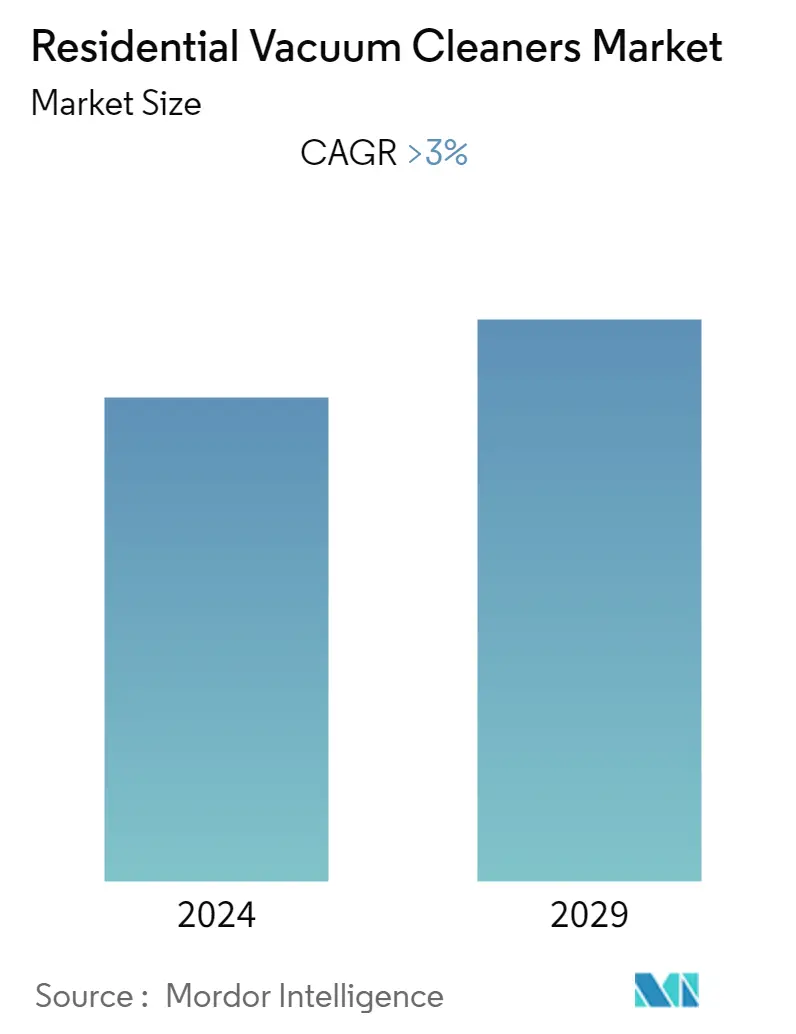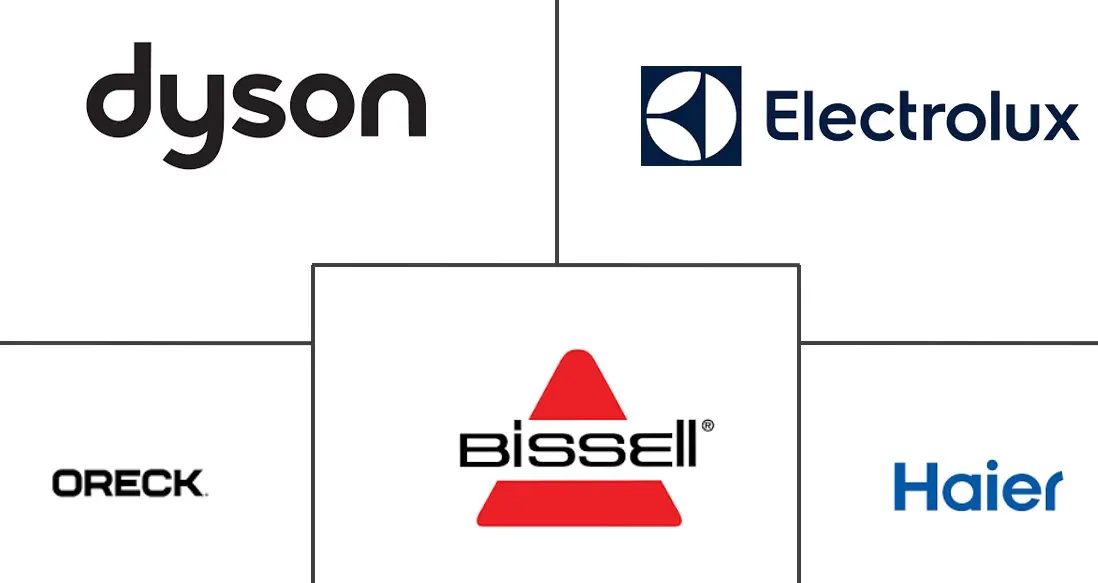Market Size of Residential Vacuum Cleaners Industry

| Study Period | 2020 - 2029 |
| Base Year For Estimation | 2023 |
| CAGR | > 3.00 % |
| Fastest Growing Market | Asia Pacific |
| Largest Market | North America |
| Market Concentration | Low |
Major Players
*Disclaimer: Major Players sorted in no particular order |
Residential Vacuum Cleaners Market Analysis
The Residential Vacuum Cleaners Market has generated a revenue of over USD 35 billion in the current year and is anticipated to register a CAGR of more than 3% for the forecast period.
Growth in the urban population in developing countries, improved infrastructural facilities, and a rise in awareness towards cleanliness and hygiene globally are factors that drive the market. Cost-effectiveness, safety, efficiency, high accessibility to small areas, and automation in residential cleaning have resulted in increased demand for vacuum cleaners. The improvement in living standards, rise in disposable income, and increase in the working population, coupled with high purchasing power, and ease of operations in vacuum cleaners are anticipated to further drive the demand for household vacuum cleaners globally.
However, unawareness, high energy consumption in the conventional type of vacuum cleaners, and high prices of robotic cleaners limit market growth. Offline sales are expected to grow at a slower pace as they are affected by increasing online sales. The demand for vacuum cleaners using high-efficiency particulate air filtration technology is increasing at a fast pace, in the developed markets.
An exponential rise in demand for vacuum cleaners was observed in the residential Vacuum cleaner market during COVID-19, primarily owing to the increased demand to maintain hygiene conditions in homes amid a surge in coronavirus cases. Post COVID-19 there are wider technological advancements in the industry to prevent virus transmission.
Residential Vacuum Cleaners Industry Segmentation
A complete background analysis of the Residential Vacuum Cleaners Market, which includes an assessment of the parental market, emerging trends by segments and regional markets, Significant changes in market dynamics, and a market overview is covered in the report. The Market is Segmented By Type (Upright, Canister, Central, Drum, Wet/Dry and Robotic), By Distribution Channel (Supermarkets/Hypermarkets, Specialty Stores, Online, and Others), by Geography (North America, Europe, Asia-Pacific, South America, and the Middle East and Africa). The report offers market size and forecast in value (USD billion) for all the above segments.
| By Type | |
| Upright | |
| Canister | |
| Central | |
| Drum | |
| Wet/Dry | |
| Robotic |
| By Distribution Channel | |
| Supermarkets/Hypermarkets | |
| Specialty Stores | |
| Online | |
| Others |
| By Geography | |
| North America | |
| Europe | |
| Asia-Pacific | |
| South America | |
| Middle East and Africa |
Residential Vacuum Cleaners Market Size Summary
The residential vacuum cleaners market is experiencing steady growth, driven by factors such as urban population expansion in developing countries, enhanced infrastructure, and a growing global awareness of cleanliness and hygiene. The demand for vacuum cleaners is bolstered by their cost-effectiveness, safety, efficiency, and ability to access small areas, along with advancements in automation for residential cleaning. Improvements in living standards, increased disposable incomes, and a rising working population with higher purchasing power further contribute to the market's expansion. However, challenges such as unawareness, high energy consumption of conventional vacuum cleaners, and the high cost of robotic models may hinder growth. The shift from offline to online sales channels is also notable, with high-efficiency particulate air filtration technology gaining traction in developed markets.
The Asia-Pacific region holds a significant share of the market, driven by the adoption of automated cleaning solutions, heightened health and hygiene awareness, and increased disposable incomes. Government initiatives and rapid urbanization in countries like India, China, and South Korea are expected to further stimulate demand. The COVID-19 pandemic notably increased the demand for vacuum cleaners as consumers prioritized home hygiene. The canister vacuum cleaner segment remains dominant due to its high suction power and user-friendly design. Major international players like Oreck Corporation, Bissell Inc., Haier Group Corporation, Electrolux Group, and Dyson Limited lead the market, competing through product breadth, volume purchasing, and effective marketing strategies. Recent collaborations and partnerships, such as those by Oreck Corporation and Eros Group, highlight ongoing efforts to enhance consumer access to advanced cleaning technologies.
Residential Vacuum Cleaners Market Size - Table of Contents
-
1. MARKET INSIGHTS AND DYNAMICS
-
1.1 Market Overview
-
1.2 Market Drivers
-
1.2.1 Hygiene and Cleanliness Awareness is Driving the Market
-
1.2.2 Urbanization is Driving the Market
-
-
1.3 Market Restraints
-
1.3.1 Economic Downturns are Restraining the Market
-
-
1.4 Market Opportunities
-
1.4.1 Technological Advancements will Create Opportunities to New Entrants
-
-
1.5 Industry Value Chain Analysis
-
1.6 Industry Attractiveness: Porter's Five Forces Analysis
-
1.6.1 Threat of New Entrants
-
1.6.2 Bargaining Power of Buyers
-
1.6.3 Bargaining Power of Suppliers
-
1.6.4 Threat of Substitutes
-
1.6.5 Intensity of Competitive Rivalry
-
-
1.7 Insights on Technological Advancements in the Market
-
1.8 Impact of COVID 19 on the market
-
-
2. MARKET SEGMENTATION
-
2.1 By Type
-
2.1.1 Upright
-
2.1.2 Canister
-
2.1.3 Central
-
2.1.4 Drum
-
2.1.5 Wet/Dry
-
2.1.6 Robotic
-
-
2.2 By Distribution Channel
-
2.2.1 Supermarkets/Hypermarkets
-
2.2.2 Specialty Stores
-
2.2.3 Online
-
2.2.4 Others
-
-
2.3 By Geography
-
2.3.1 North America
-
2.3.2 Europe
-
2.3.3 Asia-Pacific
-
2.3.4 South America
-
2.3.5 Middle East and Africa
-
-
Residential Vacuum Cleaners Market Size FAQs
What is the current Residential Vacuum Cleaners Market size?
The Residential Vacuum Cleaners Market is projected to register a CAGR of greater than 3% during the forecast period (2024-2029)
Who are the key players in Residential Vacuum Cleaners Market?
Oreck Corporation, Bissell Inc, Haier Group Corporation, Electrolux Group and Dyson Limited are the major companies operating in the Residential Vacuum Cleaners Market.

